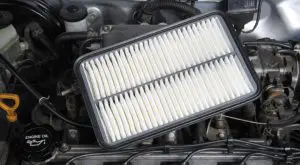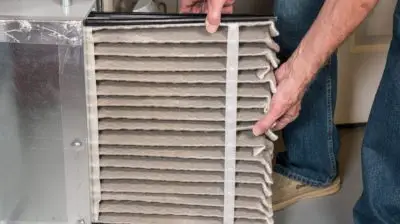When it comes to maintaining optimal air quality and efficiency in HVAC (Heating, Ventilation, and Air Conditioning) systems, one crucial element that often goes unnoticed is the standard air filter size.
It is also important to note that standard air filter sizes are often half an inch smaller than they are advertised. For example, a 16 x 25 filter will actually measure 15 1/2 x 24 1/2. This is because the filter needs to be able to move freely in the air filter frame.
If you are not sure what size air filter you need, you can always consult your HVAC system’s owner’s manual or contact a qualified HVAC technician.
What is the standard air filter size?

Standard air filter sizes are the most common sizes of air filters that are available for purchase. They are often referred to as “nominal” sizes, because they are slightly smaller than the actual dimensions of the filter. This is done to ensure that the filter fits snugly in the air filter housing, without being too tight.
The most common standard air filter sizes are:
- 10 x 20 x 1 inches
- 12 x 12 x 1 inches
- 14 x 20 x 1 inches
- 16 x 20 x 1 inches
- 16 x 25 x 1 inches
- 16 x 25 x 4 inches
- 20 x 20 x 1 inches
- 20 x 25 x 1 inches
- 20 x 30 x 1 inches
These sizes are not universal, and there may be other standard sizes that are specific to certain brands or models of HVAC systems. If you are unsure of the standard air filter size for your system, you can check the owner’s manual or contact the manufacturer.
When choosing an air filter, it is important to make sure that the size is compatible with your HVAC system. If the filter is too small, it will not be able to filter all of the air that is coming into the system. If the filter is too large, it will not fit properly in the air filter housing.
You can also find air filters that are custom-sized to fit your specific HVAC system. These filters may be more expensive, but they will ensure that the filter fits properly and provides the best possible filtration.
What is the purpose of a standard air filter?
The purpose of a standard air filter is to remove dirt, dust, pollen, mold spores, and other airborne particles from the air that is circulated through your heating and cooling system. This helps to improve the air quality in your home or office, and can also help to protect your HVAC system from damage.
Air filters are typically made of a pleated paper or fabric material, and they are designed to trap particles as the air passes through them. The size of the particles that a filter can trap is determined by its MERV rating. MERV stands for Minimum Efficiency Reporting Value, and it is a measure of how well a filter can remove particles from the air.
The higher the MERV rating, the better the filter will be at removing particles. However, higher MERV filters also tend to be more expensive. The best MERV rating for your home or office will depend on your individual needs.
In addition to removing particles, air filters can also help to remove odors and gases from the air. Some air filters contain activated carbon, which is a type of filter media that is designed to absorb odors and gases.
Also, Air filters should be changed regularly to ensure that they are effective. The frequency with which you need to change your air filter will depend on the level of air pollution in your area, as well as the size and efficiency of your HVAC system.
How does air filter size impact effectiveness?

Air filter size plays a crucial role in determining the effectiveness of an air filtration system. The size of an air filter directly influences its ability to capture and remove airborne particles, such as dust, pollen, pet dander, and other contaminants from the air.
When it comes to air filters, larger size generally translates to increased efficiency and improved performance. A larger filter provides a larger surface area for air to pass through, allowing it to trap a greater volume of airborne particles. This means that more pollutants can be captured and removed from the air, resulting in cleaner and healthier indoor air quality.
Moreover, a larger air filter tends to have a lower resistance to airflow compared to a smaller filter. This lower resistance allows for better air circulation and reduces the strain on the HVAC system. When the airflow is not impeded, the system can operate more efficiently, improving overall energy efficiency and potentially reducing utility costs.
In addition to size, it’s important to consider the MERV (Minimum Efficiency Reporting Value) rating of an air filter. The MERV rating indicates the filter’s ability to capture particles of different sizes. Higher MERV ratings typically correspond to better filtration efficiency.
However, it’s crucial to ensure that the air filter size matches the specifications of your HVAC system. A filter that is too large or too small may not fit properly, leading to air leakage around the edges and reduced effectiveness. Consulting the manufacturer’s guidelines or seeking professional advice can help you determine the appropriate filter size for your specific HVAC system.
Are there different sizes for residential and commercial systems?
Yes, there are different sizes for residential and commercial solar energy systems. Residential solar systems are typically smaller in size and designed to meet the energy needs of a single-family home or a small number of households. These systems are typically installed on rooftops or ground-mounted in residential properties.
On the other hand, commercial solar systems are larger and designed to meet the energy demands of businesses, organizations, or large-scale facilities. Commercial systems can vary significantly in size depending on the energy requirements and available space. They are often installed on rooftops, carports, or open land areas.
The size of a solar energy system is typically measured in kilowatts (kW) or megawatts (MW). Residential systems typically range from a few kilowatts to tens of kilowatts, while commercial systems can range from tens of kilowatts to several megawatts. The size of the system depends on factors such as energy consumption, available space, budget, and the desired level of energy independence.
It’s important to note that the specific sizing and design of a solar energy system should be done by a professional solar installer or engineer who can assess the individual requirements and conditions of the property.
Can non-standard sizes be used in HVAC systems?
In HVAC (Heating, Ventilation, and Air Conditioning) systems, non-standard sizes can sometimes be used, but it depends on the specific components and the overall system design.
HVAC systems typically consist of various components, including air conditioners, furnaces, heat pumps, ductwork, and ventilation equipment. These components are manufactured in standard sizes to ensure compatibility and efficiency. The most common standard sizes for HVAC equipment are based on industry standards and guidelines.
However, there are cases where non-standard sizes may be used. For example:
- Custom-built systems: In some situations, HVAC systems may be custom-built to meet specific requirements. This could involve designing and fabricating components in non-standard sizes to fit unique spaces or accommodate specific needs.
- Retrofitting and modifications: When upgrading or modifying an existing HVAC system, it may be necessary to work with non-standard sizes to integrate new equipment or make changes to the existing infrastructure.
- Specialty applications: Certain specialized applications or environments may require non-standard HVAC equipment sizes. Examples include industrial processes, cleanrooms, server rooms, or specific architectural designs that call for unconventional HVAC configurations.
However, it’s worth noting that using non-standard sizes in HVAC systems can have implications. It may require custom fabrication, increase costs, affect system performance, and potentially limit the availability of replacement parts in the future.
Therefore, it is generally advisable to consult with HVAC professionals or engineers to ensure that any deviation from standard sizes is carefully evaluated and appropriate for the specific requirements of the system.
How often should standard air filters be replaced?
Standard air filters in HVAC systems should typically be replaced every 1 to 3 months, although the exact replacement frequency can vary depending on several factors:
- Filter type: The replacement interval can depend on the type of air filter being used. There are different types of filters available, ranging from basic fiberglass filters to more advanced pleated filters or high-efficiency filters like HEPA (High-Efficiency Particulate Air) filters. Generally, higher-quality filters tend to have a longer lifespan and may require less frequent replacement.
- Indoor air quality: The air quality in your environment can impact how quickly the filter gets dirty. If you live in an area with high levels of dust, pet dander, pollen, or other airborne particles, the filter may clog more quickly and need to be replaced more frequently.
- Occupancy and lifestyle: The number of people living in a home or the level of activity in a commercial space can affect air filter lifespan. More occupants or higher levels of activity can generate more indoor pollutants, leading to faster filter clogging.
- Pets: If you have pets in your home, their fur, dander, and shedding can contribute to the accumulation of debris in the air filter. This can reduce its effectiveness and necessitate more frequent replacements.
- Allergies or respiratory conditions: Individuals with allergies or respiratory conditions may benefit from more frequent filter replacements to maintain better indoor air quality and minimize the presence of allergens or irritants.
It’s important to check the manufacturer’s recommendations for the specific air filter you are using, as they often provide guidelines on replacement intervals. Additionally, visually inspecting the filter regularly can help determine if it needs replacement sooner than the typical timeframe. If the filter appears visibly dirty or clogged, it’s a good indication that it should be replaced, regardless of the time elapsed.
Regular filter replacements are important to ensure optimal HVAC system performance, energy efficiency, and indoor air quality. A clogged or dirty filter can restrict airflow, strain the system, reduce efficiency, and potentially lead to increased energy consumption and poor indoor air quality.
Do different HVAC brands have different sizes?
Yes, different HVAC brands have different sizes. The size of an HVAC unit is determined by its cooling capacity, which is measured in BTUs (British Thermal Units). The amount of BTUs required to cool a home depends on the home’s square footage, climate, and insulation.
In general, HVAC brands offer a range of sizes for their units. For example, a particular brand might offer 1.5-ton, 2-ton, 3-ton, and 4-ton units. The specific sizes offered by a brand will vary depending on the brand’s product lineup and the needs of their target market.
It is important to note that not all HVAC brands offer the same range of sizes. Some brands may only offer smaller units, while others may offer larger units. It is important to do your research and compare different brands to find the right size unit for your home.
What happens if an improperly sized filter is used?

Using an improperly sized air filter can have a number of negative consequences, including:
- Reduced air flow. If the filter is too small, it will not be able to accommodate the full flow of air from your HVAC system. This can cause the system to work harder to circulate air, which can lead to decreased efficiency and higher energy bills.
- Increased dust and dirt buildup. If the filter is too small, it will not be able to catch all of the dust and dirt that is circulating through your HVAC system. This can lead to increased levels of allergens and pollutants in your home, which can trigger allergies, asthma, and other respiratory problems.
- Damage to HVAC system. If the filter is too small, it can become clogged with dust and dirt very quickly. This can restrict airflow even further and can even damage the motors and blowers in your HVAC system.
- Fire hazard. If the filter is too small, it can become clogged with flammable dust and dirt. This can create a fire hazard, especially if the filter is located near a heat source.
To avoid these problems, it is important to use the correct size air filter for your HVAC system. The size of the filter is typically stamped on the side of the filter or in the owner’s manual for your HVAC system. If you are not sure what size filter you need, you can always consult with a qualified HVAC technician.
What factors affect the selection of air filter size?
Several factors can influence the selection of air filter size. Here are some key considerations:
- HVAC System Requirements: The first step is to check the specifications and requirements of your HVAC (Heating, Ventilation, and Air Conditioning) system. The manufacturer or the system manual usually provides guidelines on the appropriate filter size for your specific system. It’s important to choose a filter size that is compatible with your HVAC system’s dimensions and airflow capacity.
- Airflow Rate: The airflow rate, measured in cubic feet per minute (CFM), is a crucial factor when selecting an air filter size. The filter should allow sufficient airflow to meet the requirements of your HVAC system without causing excessive strain or decreased performance. Insufficient airflow can lead to reduced efficiency, while excessive airflow can result in poor filtration.
- Filter Location: Consider the location of the filter within your HVAC system. Some systems have filters located in the return air ducts, while others have them in the air handler or furnace. The available space in the filter compartment or housing will determine the maximum size of the filter that can be accommodated.
- Filter Efficiency: Different air filters have varying levels of efficiency in capturing airborne particles. Filters are assigned a MERV (Minimum Efficiency Reporting Value) rating that indicates their effectiveness. Higher MERV ratings indicate better filtration but may also result in increased resistance to airflow. Balancing filtration efficiency with system airflow requirements is important when selecting a filter size.
- Environmental Factors: Consider the air quality in your environment and the specific contaminants you want to remove. For example, if you live in an area with high levels of pollen or allergens, you might choose a filter with a higher MERV rating to enhance the filtration of those particles.
- Maintenance and Replacement: The size of the air filter can affect how frequently it needs to be replaced. Smaller filters may have a shorter lifespan and require more frequent replacement compared to larger filters. Consider the cost and effort associated with filter replacement when selecting the size.
It’s crucial to consult with a professional HVAC technician or refer to the system manual to ensure you select the appropriate air filter size for your specific HVAC system and indoor air quality needs.
Are there standard sizes for portable air purifiers?
Yes, portable air purifiers often come in standard sizes to accommodate various room sizes and airflow requirements. While the specific dimensions may vary between manufacturers and models, there are common standard sizes available in the market.
Here are some typical sizes you may come across:
- Small or Compact: These portable air purifiers are designed for small spaces such as offices, bedrooms, or small living rooms. They typically have a compact form factor with dimensions ranging from 10 inches (25 cm) to 18 inches (45 cm) in height.
- Medium: Portable air purifiers in the medium size range are suitable for larger rooms or open floor plans. They provide higher airflow capacity and filtration capabilities. The height of medium-sized units can range from 18 inches (45 cm) to 24 inches (60 cm) approximately.
- Large or Tower: These air purifiers are designed for even larger spaces such as living rooms, open-concept areas, or commercial settings. They often have a tower-like shape and can stand anywhere from 24 inches (60 cm) to 36 inches (90 cm) tall or even taller.
It’s important to note that these are general guidelines, and the actual dimensions may vary depending on the specific model and features of the portable air purifier. When selecting a portable air purifier, consider the size of the room you intend to use it in, the desired airflow rate, and the filtration efficiency required for your specific needs.
Always refer to the manufacturer’s specifications to ensure you choose the appropriate size and model for your intended application.
Conclusion
Getting the right standard air filter size will sure help you make the right decision. While there are standard sizes for air filters used in HVAC systems, the specific dimensions may vary depending on the manufacturer and model.
These standard sizes are designed to accommodate different HVAC system requirements and airflow rates. It’s important to consult the manufacturer’s guidelines or system manual to determine the appropriate filter size for your specific HVAC system.


